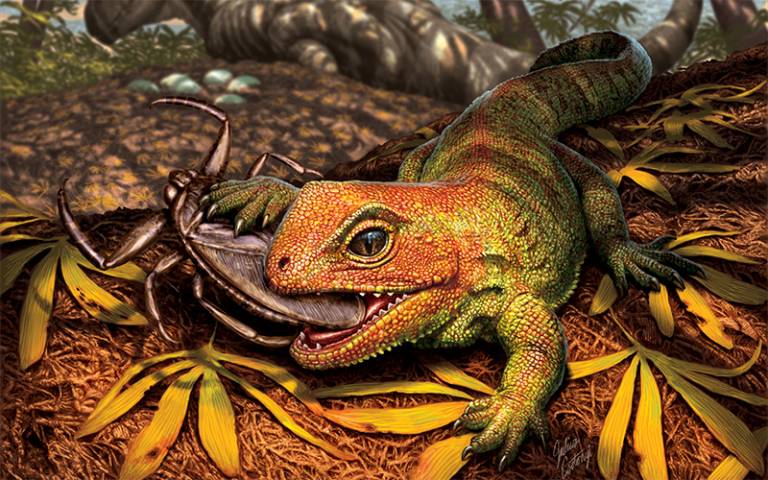Extinct prehistoric reptile that lived among dinosaurs discovered
26 September 2022
An extinct species of lizard-like reptile that belongs to the same ancient lineage as New Zealand’s living tuatara has been discovered by a team involving a UCL researcher.

The researchers describe the new species Opisthiamimus gregori, which once inhabited Jurassic North America about 150 million years ago alongside dinosaurs like Stegosaurus and Allosaurus, in a paper published in the Journal of Systematic Palaeontology.
In life, this prehistoric reptile would have been about 16 centimetres from nose to tail—and would fit curled up in the palm of an adult human hand—and likely survived on a diet of insects and other invertebrates.
Co-author Dr Matthew Carrano (National Museum of Natural History, Smithsonian Institution) said: “What’s important about the tuatara is that it represents this enormous evolutionary story that we are lucky enough to catch in what is likely its closing act. Even though it looks like a relatively simple lizard, it embodies an entire evolutionary epic going back more than 200 million years.”
The discovery comes from a handful of specimens including an extraordinarily complete and well-preserved fossil skeleton excavated from a site centred around an Allosaurus nest in northern Wyoming’s Morrison Formation in the US. Further study of the find could help reveal why this animal’s ancient order of reptiles were winnowed down from being diverse and numerous in the Jurassic to just New Zealand’s tuatara surviving today.
The tuatara looks a bit like a particularly stout iguana, but the tuatara and its newly discovered relative are in fact not lizards at all. They are rhynchocephalians, an order that diverged from lizards at least 240 million years ago.
In the Jurassic, rhynchocephalians were found nearly worldwide, came in sizes large and small, and filled ecological roles ranging from aquatic fish hunters to bulky plant munchers. But for reasons that still are not fully understood, rhynchocephalians all but disappeared as lizards and snakes grew to be the more common and more diverse reptiles across the globe.
This evolutionary chasm between lizards and rhynchocephalians helps explain the tuatara’s odd features such as teeth fused to the jawbone and a unique chewing motion that slides the lower jaw back and forth like a saw blade.
Co-author Dr Marc Jones (UCL Cell & Developmental Biology and Natural History Museum) said: “Some scientists have suggested that the majority of rhynchocephalians disappeared due to competition from lizards because the spread of lizards in northern continents appears to mirror the disappearance of rhynchocephalians. Others have speculated that their disappearance might be related to mammals given that the linage leading to the tuatara survived on New Zealand without mammals. However, the global shifts in climate, vegetation, and ground cover may also have played a role. We still do not fully understand what happened to this once-mighty group of animals, but our latest discovery is important because it’s from a locality where rhynchocephalians and lizards appear to have co-existed.”
Following O. gregori’s formal description, the fossil has been added to the National Museum of Natural History’s collections where it will remain available for future study, perhaps one day helping researchers figure out why the tuatara is all that remains of the rhynchocephalians, while lizards are now found across the globe.
The researchers named the new species after National Museum of Natural History volunteer Joseph Gregor who spent hundreds of hours meticulously scraping and chiselling the bones from a block of stone that first caught museum fossil preparator Pete Kroehler’s eye back in 2010.
The fossil is almost entirely complete, with the exception of the tail and parts of the hind legs. The researchers say that such a complete skeleton is rare for small prehistoric creatures like this because their frail bones were often destroyed either before they fossilised or as they emerge from an eroding rock formation in the present day. As a result, rhynchocephalians are mostly known to palaeontologists from small fragments of their jaws and teeth.
After the team had freed as much of the tiny fossil from the rock as was practical given its fragility, they set about scanning the fossil with high-resolution computerized tomography (CT), a method that uses multiple X-ray images from different angles to create a 3D representation of the specimen.
Once the fossil’s bones had been digitally rendered with accuracy smaller than a millimetre, the researchers set about reassembling the digitised bones of the skull, some of which were crushed, out of place or missing on one side, using software to eventually create a nearly complete 3D reconstruction. The reconstructed 3D skull now provides researchers an unprecedented look at this Jurassic-age reptile’s head.
Given Opisthiamimus’s diminutive size, tooth shape and rigid skull, it likely ate insects, potentially including prey with harder shells such as beetles or water bugs. Broadly speaking, the new species looks quite a bit like a miniaturised version of its only surviving relative (tuataras are about five times longer).
Co-author Dr David DeMar Jr. (National Museum of Natural History, Smithsonian Institution) said: “Such a complete specimen has huge potential for making comparisons with fossils collected in the future and for identifying or reclassifying specimens already sitting in a museum drawer somewhere. With the 3D models we have, at some point we could also do studies that use software to look at this critter’s jaw mechanics.”
Funding and support for this research were provided by the Smithsonian and the Australian Research Council.
Links
- Research paper in Journal of Systematic Palaeontology
- UCL Cell & Developmental Biology
- UCL Biosciences
- UCL Faculty of Life Sciences
Source
Image
- Credit: Julius Csotonyi for the Smithsonian Institution
Media contact
Chris Lane
tel: +44 20 7679 9222
E: chris.lane [at] ucl.ac.uk
 Close
Close

